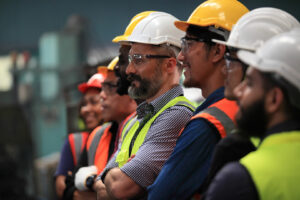
A construction site is often viewed to be a risky workplace. The key to improving safety and wellness on-site is innovation and improvements in best practices.
Why shouldn’t we just give the same attention to other types of risks in the organisation when we can achieve so much in the health and safety field so successfully?
Is your supply chain the most vulnerable part of your business?
For many firms in the construction business, their supply chain partners are both an asset and a risk. “Fundamentally, a principal contractor may live or die by the performance of their subcontractors,” says Andy Chisholm, Construction Risk Engineer at Zurich Risk Engineering UK.
The employment of subcontractors helps the principal contractor to undertake more complicated projects without unacceptably raising their risk. However, there has also been a concern about the predominance of subcontractors since the main contractor is less in control of each individual subcontractor’s training and skills programme which can have detrimental effects on performance and quality.
Subcontractors are increasingly now subcontracting parts of their work package to other suppliers. As a result, complex supply chains have been developed with multiple levels of suppliers, some of which may be completely anonymous to the client. Many suppliers in large or complicated projects usually have responsibility and efficiency down the supply chain. During the first and second levels of the supply chain, contractual liabilities might diminish until suppliers are not locked in at the end of the chain.
Increased liabilities and potential legal consequences in the case of financial, environmental, technical, or security failures represent a major risk to the sector with inadequately insured or unaccredited suppliers.
In the end, a failure of the supply chain will result in delays, cancellation, conflicts and have a detrimental impact on the schedule and costs of the projects. It might also ruin your credibility in the construction industry.
Identifying red flags within the supply chain
What are some of the indicators of potential issues within your supplier base?
- Not providing timely, correct and complete submittals
- Higher levels of discrepancies, issues and variation in orders
- Frequent and unexpected changes in workforce or contacts
- Frequent challenges with management and workplace resources (admin efficiency)
- Reduced sales ratios (payables and receivables)
- Limited credit lines
Risk Mitigation
What can you do to mitigate the risks within the supply chain?
Analyse Finance Risks
Get financial statements examined by subcontractors or through reputable credit agencies in good time. Then analyse potential subcontractors based on your own defined risk criteria using standard metrics. Extra attention should be paid to a financial situation of a subcontractor, without cash, a slow-paying client or a major contractor might lead to a dispute.
Audit the Workforce Skills
Does the subcontractor have competence with the comparable size and scope of projects? Pay special attention to subcontractors offering a range of services. Can they exhibit their skill in these multiple services?
Are they nearby? Subcontractors may again declare that they are operating nationally. Have they got the labour coverage? Do they have exposure because of local workforce fluctuations and are they simply subcontracting down another level for local coverage?
Assess the Contractor’s History
When you need a job doing quickly, because as we know, projects don’t wait, it’s good to take a step back and look at the relationship with the contractor overall. How did you become aware of the subcontractor? Did they previously work with you or for your company? What was your experience like? Do you have a comprehensive subcontractor performance reporting method? Is this information shared amongst the project teams?
Continual Evaluation
Using a PQQ method or other accreditation checking services to choose partner companies is all well and good, but remember, it is not a one-time event for subcontractors.
Consider updating PQQ frequently, or as the spec and scope of projects change significantly enough to warrant checking the credentials again.
Restrict your exposure
Issues are not prevented by even the finest prequalification methods.
Therefore, constraints on your project exposure (project limit) and limitations on a given subcontractor for all projects should be taken into account. This could take the form of a contract limit based on a percentage of subcontractor turnover so that your exposure is minimised.
Build Stronger Relationships with SRM
Good relationships with your subcontractors are vital. Sustaining and developing effective supply chain relationships are important to confidence on both sides.
Evolution – Not Revolution
We’re firm believers in that if you measure it you can manage it.
So evaluating how your subcontractors and your larger construction supply chain partners are performing helps you get in control and manage risks as much as possible. Visibility is everything.
Do you have the strategies and methods in place to reduce your risks? Do you have a collaborative working partnership with the supply chain? Do you require Supply Chain Software system to help you manage it?
By adopting a holistic solution for your construction supply chain, where data, procurement and relationship management is all in one place you will have the capability to reduce the above-mentioned risks. You’ll encourage your supply chain to work with you more closely, avoid audit anxiety and develop more robust and resilient future work pipelines and therefore a degree of business certainty.
It’s not as simple as carrot vs. stick as no supplier base is infinite so continual, reciprocal improvements mean success for everyone through cooperation, collaboration and 360-degree reporting to give visibility.





